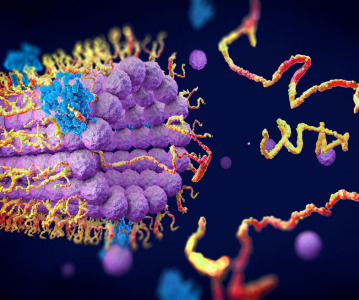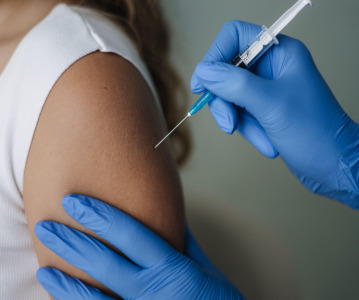Extension Study Data Supporting Long-Term Safety and Efficacy of Eloctate Published in Haemophilia

Biogen and Swedish Orphan Biovitrum AB (publ) (Sobi) have announced newly published clinical data demonstrate that people on extended-interval prophylaxis regimens with Eloctate [Antihemophilic Factor (Recombinant), Fc Fusion Protein] experienced low bleeding rates. The interim results of this Phase III, open-label extension study called ASPIRE were published in the online edition of Haemophilia, the journal of the World Federation of Hemophilia, the European Association for Haemophilia and Allied Disorders, and the Hemostasis & Thrombosis Research Society.
Study participants completing the Phase III A-LONG and Kids A-LONG studies were eligible to participate in ASPIRE. The results to-date show the majority of participants in ASPIRE, maintained or extended their dosing intervals between treatments compared to the A-LONG and Kids A-LONG studies. As of the interim analysis, the median time in the ASPIRE study was 80.9 weeks for adults and adolescents completing the A-LONG study, and 23.9 weeks for children completing the Kids A-LONG study. Inhibitor development is the primary endpoint of ASPIRE and no inhibitors were reported in any treatment groups. Through the interim ASPIRE analysis, adults and adolescents experienced annualized bleeding rates (ABRs) of 0.66, 2.03 and 1.97 in the individualized, weekly and modified prophylaxis arms, respectively. Children on individualized prophylaxis also experienced low bleeding rates, with an overall median ABR of 0.0 in children less than 6 years of age, and 1.54 for children ages 6 to 12. These results were consistent with data from the Phase III A-LONG and Kids A-LONG studies.
In addition to efficacy and safety endpoints, the publication also reports changes in prophylactic infusion frequency from the end of the A-LONG study through the interim analysis. Of the adults and adolescents who had previously been treated prophylactically and who remained in the study through the interim analysis (n=128), 72% maintained their prophylactic dosing interval and 22% lengthened and 6% shortened the time between infusions. Extension study participants could change treatment group at any time.
“The design of the ASPIRE study provides physicians a high degree of dosing flexibility, with the goal of reflecting their real-world treatment practices,” said Guy Young, Director of the Hemostasis and Thrombosis Center, Children’s Hospital of Los Angeles. “The results suggest prophylaxis with Eloctate shows efficacy and safety for the long-term treatment of hemophilia A.”
In ASPIRE, most participants received prophylactic treatment and were able to maintain protection against bleeding episodes with Eloctate consumption that was consistent with that observed in A-LONG and Kids A-LONG.
Related News
-
News A Day in the Life of a Start-Up Founder and CEO
At CPHI we work to support Start-Up companies in the pharmaceutical industry and recognise the expertise and innovative angles they bring to the field. Through our Start-Up Programme we have gotten to know some of these leaders, and in this Day in the ... -
News Biopharmaceutical manufacturing boost part of new UK government budget
In their national budget announced by the UK Labour Party, biopharmaceutical production and manufacturing are set to receive a significant boost in capital grants through the Life Sciences Innovative Manufacturing Fund (LSIMF). -
News CPHI Podcast Series: The power of proteins in antibody drug development
In the latest episode of the CPHI Podcast Series, Lucy Chard is joined by Thomas Cornell from Abzena to discuss protein engineering for drug design and development. -
News Amgen sues Samsung biologics unit over biosimilar for bone disease
Samsung Bioepis, the biologics unit of Samsung, has been issued a lawsuit brought forth by Amgen over proposed biosimilars of Amgen’s bone drugs Prolia and Xgeva. -
News CPHI Podcast Series: Why we need to consider women in clinical trials
The latest episode of the CPHI Podcast Series with Lucy Chard covers women's health, specifically women's representation in clinical trials, the associated bias, and the impacts on health for this population. -
News US FDA does not approve MDMA therapy for PTSD, requests more data
The MDMA-based therapeutic developed by Lykos Therapeutics, a California-based Public Benefit Corporation (PBC), has been reviewed and unapproved by the US FDA. The regulator has requested additional phase III trial data for further safety and efficacy... -
News Novartis and Viatris latest facing lawsuit over HeLa cell misuse
Global pharmaceutical companies Novartis and Viatris are the latest hit with a lawsuit claim pertaining to alleged misuse of the ‘HeLa’ cell line from the estate of woman whose cancerous tissue cells were taken without consent. -
News Sanofi invests billions into Frankfurt insulin production site
French pharmaceutical company Sanofi have announced an investment of EUR1.3 billion at their existing BioCampus site in Frankfurt am Main for the expansion of insulin production.
Position your company at the heart of the global Pharma industry with a CPHI Online membership
-
Your products and solutions visible to thousands of visitors within the largest Pharma marketplace
-
Generate high-quality, engaged leads for your business, all year round
-
Promote your business as the industry’s thought-leader by hosting your reports, brochures and videos within your profile
-
Your company’s profile boosted at all participating CPHI events
-
An easy-to-use platform with a detailed dashboard showing your leads and performance



.png)

.png)
.png)
.png)